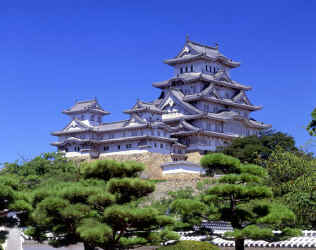|
AsianInfo.org
supports I.C.E.Y. -
H.O.P.E. (non-profit org)
(International
Cooperation of Environmental Youth - Helping Our Polluted
Earth) Any advertisement you view helps save the
environment! Thanks!

Himeji
Castle
The
introduction of Buddhism into Japan in 538, also brought
many architects from the Korean peninsula with new
techniques reflecting the Chinese (Northern Wei) style of
Buddhist architecture. Horyuji, a temple in Nara
whose main hall and pagoda date back to the Asuka period,
was built in this style. Architecture during the Nara
period (710-794) was influenced by the Tang style which
was characterized by stable and balanced proportions and
by an emphasis on structure over ornamentation. The
lecture hall of Toshodaiji, a temple in Nara, is one of
the finest representations of this style.
Domestic
architecture during the Muromachi period (1333-1573)
witnessed the perfection of the shoin-zukuri style,
which is the precursor of the style of the present-day
Japanese house with tatami mats covering floors.
From about this time, with the completion of the shoin-zukuri
style of residential architecture, ikebana and the tea
ceremony became popular, and still are to this day.
More...
Back to Top
The
Momoyama period (1573-1603) brought about an increased
awareness of culture, through merchants who amassed wealth
through overseas trade. An example is the
popularization and spread of the tea ceremony, which led
to the development of sukiya-zukuri, an
architectural style exclusively for tea ceremony purposes.
This style is still used in architecture today.
Western
styles of architecture have spread rapidly since the Meiji
period and today, Japanese cities are dominated by forests
of modern skyscrapers, some of them employing traditional
Japanese design here and there.
Architecture
has evolved quite a bit since the heavy Chinese influence
early in Japan's history. It has changed to suit the
needs of the people and with the ever increasing
influences brought in. Buddhism had a tremendous
influence that is still present today by way of temples.
It eventually affected the nature of Shino worship
as well as taking elements from Buddhist architecture and
incorporating it.
More
recently, Western influences have changed the way Japanese
use raw materials. More stone and bricks are used in
construction while still attempting to keep the aspect of
traditional Japanese architecture. Even with all the
changes, the traditional Japanese style hasn't completely
disappeared. A minor example of this is that the custom of
removing one's shoes before entering a house is still
commonly practiced.
More...
Back to Top
|





